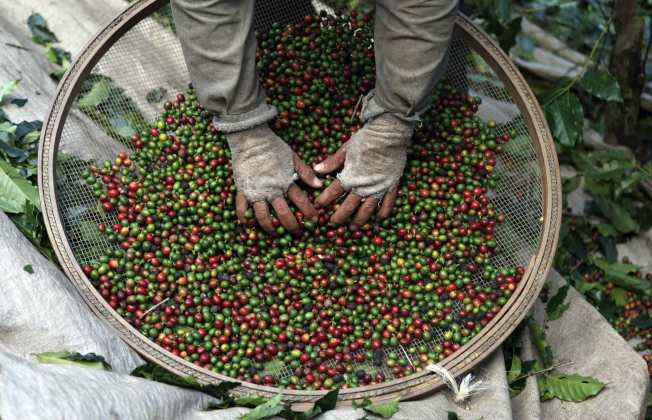Prices plummet Latin American coffee industry is in crisis Colombian farmers switch to cocoa beans

Professional coffee knowledge exchange more coffee bean information please follow the coffee workshop (Wechat official account cafe_style)
The price of international coffee beans has fallen to a 13-year low, prompting many disappointed farmers in Central and South American countries to give up cultivation, raising fears that the coffee industry will fall into crisis. Experts pointed out that the outlook for coffee bean prices will depend on the exchange rate trend of Brazil's Lille.
Although the July futures price of Arabica coffee beans on the New York Intercontinental Exchange (ICE) rebounded 3.6% to 92.90 cents per pound on the 19th, it is still near a 13-and-a-half-year low. At one point, the futures fell to 89 cents per pound, the lowest since September 2005.
However, the production costs of many coffee farms in Central America range from $1.2 to $1.50 per pound, leaving most coffee producers feeling helpless.
The main reason for the weak price of coffee beans is the increase in Brazilian supply (about 25% of the world's total). According to Brazilian government data, total production reached an all-time high of 62 million bags (60 kg each) in 2018, coupled with the devaluation of Brazil's Lille, prompting Brazilian coffee suppliers and exporters to expand exports, leading to further weakness in dollar-denominated international coffee prices. Brokers pointed out that Brazilian companies accelerated their exports in the first quarter of this year, with exports surging 500000 bags in February compared with the same period last year.
The Brazilian government expects coffee production in Brazil to be 15% lower this year than last year, a reduction of about 55 million to 60 million bags.
Coffee bean production in Brazil often changes on a two-year cycle; for example, it increased last year and will decrease this year, allowing coffee trees to recover. However, according to the Brazilian Agricultural Agency, even if the output is reduced to 52.5 million bags this year, it is still the highest level of the "year of production reduction" and higher than the previous "year of increase", except in 2018.
British broker Marex pointed out that the severe downturn is driving some marginal producers out of the market, which will hit the output of all Central American countries in the 2019 and beyond production season. The key factor affecting the coffee market is still the Lille exchange rate, and the future trend of the Lille depends on whether the Brazilian government's annuity reform bill can pass, and whether the fiscal revenue and expenditure can be improved.
Mela, an analyst at Rabobank, pointed out that "the outlook for the coffee market depends on the trend of Lille and the competitiveness of Brazilian coffee growers." The collapse in coffee prices has prompted Guatemalan farmers to give up their farms, while Colombian farmers have switched to cocoa beans.
END
Important Notice :
前街咖啡 FrontStreet Coffee has moved to new addredd:
FrontStreet Coffee Address: 315,Donghua East Road,GuangZhou
Tel:020 38364473
- Prev

The cash on the account is expected to be burned up by the end of September! Luckin Coffee submitted a prospectus for listing
Professional coffee knowledge exchange more coffee bean information please follow the coffee workshop (Wechat official account cafe_style) Luckin Coffee is really going on the market. Today, Luckin Coffee formally submitted a prospectus to the US Securities and Exchange Commission, intending to land on NASDAQ to raise US $100m. Lucky IPO, who has been stuck in the stage of rumors and speculation, finally got hammered. A lot of accumulation
- Next

"Duoduo Farm Garden" advances Yunnan Coffee pinduoduo challenges Starbucks
Professional coffee knowledge exchange more coffee bean information Please follow the coffee workshop (Wechat official account cafe_style) following Starbucks using Yunnan coffee as one of its raw materials, Chinese e-commerce company pinduoduo has also crowded into this coffee base. Pinduoduo announced on the 22nd that it plans to launch more than 1,000 agricultural garden projects, the first stop is located in Baoshan, Yunnan, and pinduoduo's price for buying raw coffee beans is also high.
Related
- Why can American refills for free? The difference between Americano and American drip pot coffee
- Being chased out of the rain in front of Starbucks?! Store: Sheltering from rain under umbrellas poses a safety hazard
- The white moonlight has changed?! Lucky launches "Big Winter Pear American"
- Hand-brewed coffee three-stage method, high-sweet and universal brewing method to share! What does the high sweet water level of hand-brewed coffee mean?
- What is the difference between raw, refined and full espresso coffee? How to extract espresso and taste good?
- A complete list of coffee bean names and their meanings! What is Yejia Shefi coffee? Where is Mantelin coffee?
- What grade does Arida Manor Kaduai coffee beans belong to? What treatment is Arida ASD slow anaerobic sun exposure?
- The milk tea cup becomes smaller?! Overlord Tea Girl launches a new "Return to Yunnan" series
- Accused of selling counterfeit and high-priced coffee beans! Well-known boutique coffee brand "Oukelao" bowed and apologized!
- How to make espresso dumplings? Can I eat coffee and glutinous rice balls together?

